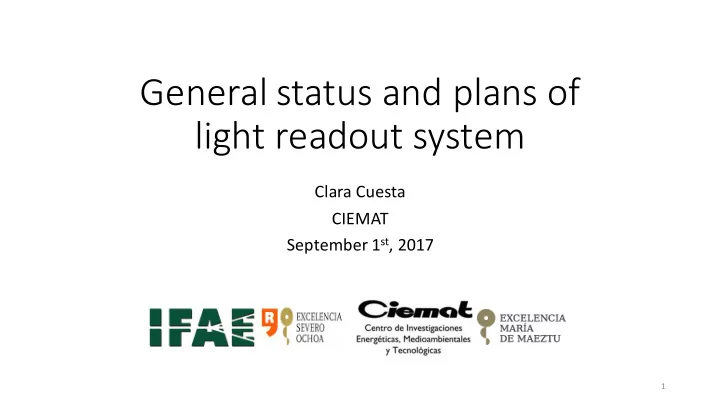

General status and plans of light readout system Clara Cuesta CIEMAT September 1 st , 2017 1
Light Readout System Status 1. Procurement of 40 8” Hamamatsu R5912-20mod PMTs (DONE) 2. Design, production and tests of the PMT bases (DONE) 3. Design, construction and assembly of the PMT mechanics (DONE) 4. Characterization of the PMT system at dedicated setup @CIEMAT at room and cryogenic temperature (Almost finished, sept) 5. Design and validation of the light calibration system (on-going, sept) 6. Training people for installation at ENH1 (on-going) 7. HV splitters production and tests (Sept-Nov) 8. PMT TPB coating at CERN (Oct-Nov) PMTs ready for installation in Dec 2017 at CERN 2
PMT Characterization Status 40 PMTs tested at RT and CT: • 33 PMTs: DC and gain ok • 1 PMT returned to Hamamatsu as gave no signal -> replaced and tested ok • 1 PMT returned to Hamamatsu due to high DC at RT -> replaced and tested ok • 5 PMTs under further study due to high DC • Operating voltagedetermined • Information about measurements to be added to the database. • Usuallytested in LN 2 (77 K), also an overpressure test (+1 bar, 83 K) at to study gain dependence with temperature • Detailed results can be presented anytime 3
Light Calibration System Black box with light source (KaputschinskyLEDs) • outside of cryostat 6 fibers going to cryostat - φ 1000 mm, M59L01 • 2 CF40 , each with 3 optical feedthroughs • Inside the cryostat ( 6x ): • 0.39 NA TECS TM Hard Clad, Step-Index, Multimode Fiber from Thorlabs 22.5 m fiber - φ 800 mm, FT800UMT, SS jacket • 3 m 1-to-7 bundle – φ 200 mm, FT200UMT • SS jacket common end, black jacket at split ends Vacuum compatible SMA to SMA matting • sleeve All fibers with SMA connectors • 4
Light Source • Blue LED of 470 nm for calibration Reference Position of LED Sensor • Kapuschinski circuit as LED driver: adjustable • 15-20 ns total width • intensity tunable • 1 LED connected to 1 fiber going to one optical feedthrough Stray light LED Feedthrough Fiber • 6 LEDs in total placed in an hexagonal geometry • Direct light to fiber, stray light to reference sensor • 1 reference sensor in center: Sensl SiPM (2 outputs: fast and slow) • Controlled by BeagleBone (pulsing, ADC for SiPM, DAQ) 5
Light Source KapuschinskyLED tests: Frequency Stability Power (W) Power (W) To do • Assemble the final LED PCBs (6x) • Characterize them the same way 1,2,… 10 kHz 100 Hz Kaput. LED (PM Res.) 1 kHz Time (hours) V (V) 6
Inner Fibers Almost complete setup under testing in LN 2 : optical Vacuum compatible 1 m** 1-to-7 bundle 22.5 m fiber SMA to SMA feedthrough* 8” PMT φ 200 µ m, FT200UMT φ 800 µ m, FT800UMT matting sleeve *Final design 3 feedthroughs per flange **Final design 3 m 7
Inner Fibers Light transmission has been measured: optical Vacuum compatible 1 m 1-to-7 bundle 22.5 m fiber SMA to SMA feedthrough 8” PMT φ 200 mm, FT200UMT φ 800 mm, FT800UMT matting sleeve Light transmission: RT: 0.7 x 0.117 x 0.7 x 0.06 = 0.003 total CT: 0.7 x 0.08 x 0.6 x 0.05 = 0.002 total On-going measurements at CT to determine light range required at flange to see SPE – 200 PE at PMTs 8
Summary 36 8” cryogenic photomultipliers • – 40 PMT finishing characterization at RT and CT – Information will be in database • PMT mechanics: final support assembled • PMT bases soldered to PMTs Wavelength-shifter: TPB coating on PMT at CERN (Oct-Nov) • Light calibration system validation (Sept) • HV splitters production and tests (Sept-Nov) • PMT TPB coating at CERN (Oct-Nov) • Training people for installation • 9
Recommend
More recommend